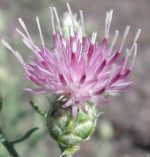
Russian knapweed is a woody , rhizomatous perennial and member of the aster family, Asteraceae, that also includes sunflower, yarrow, and lettuce. It is native to Eurasia but was introduced into the US in the 19th century and is now widespread especially in the western two thirds of the US where it grows in disturbed sites such as cultivated fields, orchards, pastures, and roadsides. Plants are considered invasive and are of special concern to horse owners because they contain sesquiterpene lactones that cause equine parkinsonism, a usually fatal disease that effects the mouth muscles of horses.
Description: Russian knapweed grows up to three feet tall from a deep, black, scaly root system and has hairy, woody, ridged, branching stems. The lower leaves are two to four inches long, hairy and deeply lobed while the upper leaves are smaller, hairy and unlobed. White, light pink or lavender flowerheads are 1/4 to 1/2″ across and appear singly at the tips of the branches from June to fall. The small seeds are flattened and have small white bristles. Plants spread by seeds and rhizomes.
Control: Russian knapweed is difficult to eradicate because of the rhizomes that sprout and produce new plants. Hoe or pull seedlings as soon as they appear; dig , cut, or mow larger plants being careful to get all of the root system; do not let plants set seed. Herbicides such as glyphosate may be necessary for severe infestations and are best applied when the plants are in the bud to early bloom stage, or in the fall after a light frost. A gall nematode, Subanguina picridis, is available for biological control.